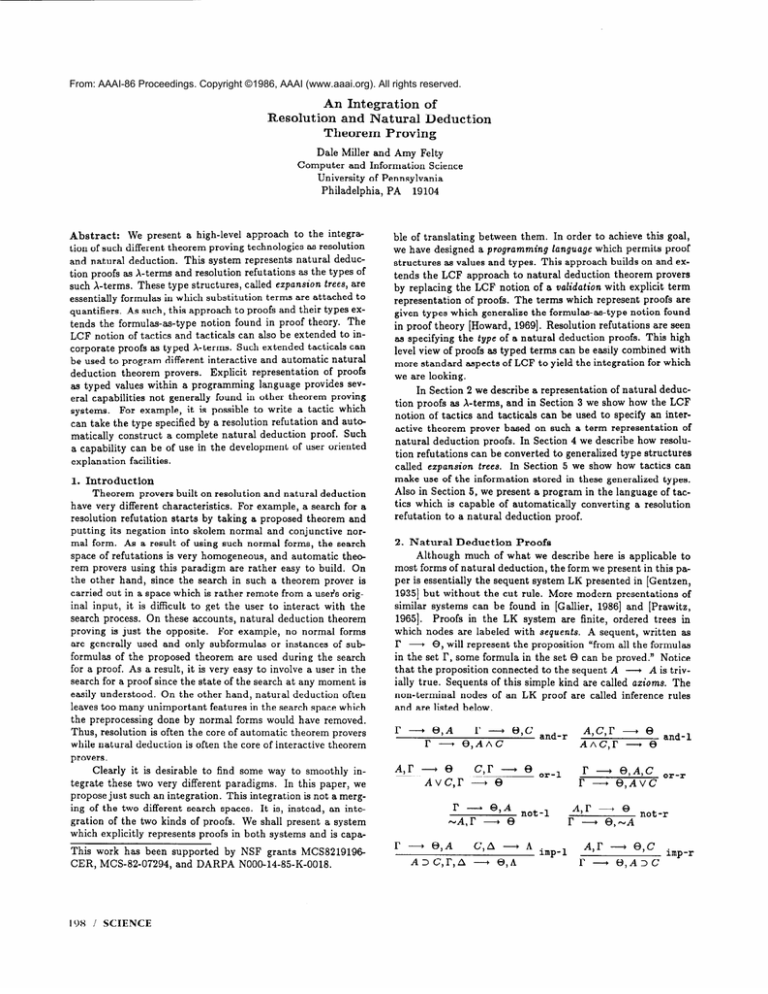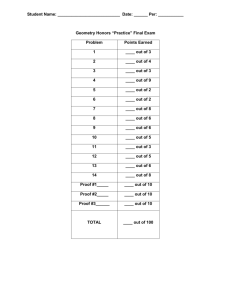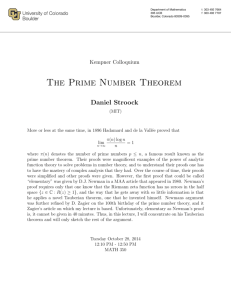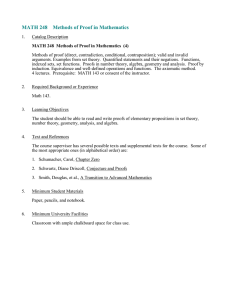An Integration of Theorem Proving 19104
advertisement

From: AAAI-86 Proceedings. Copyright ©1986, AAAI (www.aaai.org). All rights reserved.
An Integration of
Resolution and Natural Deduction
Theorem Proving
Dale Miller and Amy Felty
Computer
and Information
Science
University
of Pennsylvania
19104
Philadelphia,
PA
Abstract:
We present
a high-level
approach
to the integration of such different theorem
proving technologies
as resolution
and natural
deduction.
This system represents
natural
deduction proofs as X-terms and resolution
refutations
as the types of
such X-terms.
These type structures,
called ezpansion
trees, are
essentially
formulas
in which substitution
terms are attached
to
quantifiers.
As such, this approach
to proofs and their types extends the formulas-as-type
notion found in proof theory.
The
LCF notion of tactics and tacticals
can also be extended
to incorporate
proofs as typed X-terms.
Such extended
tacticals
can
be used to program
different
interactive
and automatic
natural
Explicit
representation
of proofs
deduction
theorem
provers.
ble of translating
between
them.
In order to achieve this goal,
we have designed
a programming language which permits
proof
structures
as values and types. This approach
builds on and extends the LCF approach
to natural
deduction
theorem
provers
by replacing
the LCF notion of a uakfation with explicit term
representation
of proofs.
The terms which represent
proofs are
given types which generalize
the formulas-as-type
notion found
in proof theory [Howard,
19691. Resolution
refutations
are seen
aa specifying
the type of a natural
deduction
proofs.
This high
level view of proofs as typed terms can be easily combined
with
more standard
aspects of LCF to yield the integration
for which
as typed values within a programming
language
provides
several capabilities
not generally
found in other theorem
proving
systems.
For example,
it is possible
to write a tactic which
can take the type specified by a resolution
refutation
and automatically
construct
a complete
natural
deduction
proof.
Such
a capability
can be of use in the development
of user oriented
a representation
of natural
deducIn Section 2 we describe
tion proofs as X-terms, and in Section 3 we show how the LCF
notion of tactics
and tacticals
can be used to specify an interactive theorem
prover based on such a term representation
of
natural
deduction
proofs.
In Section 4 we describe
how resolution refutations
can be converted
to generalized
type structures
can
called expansion trees. In Section 5 we show how tactics
explanation
facilities.
1. Introduction
Theorem
provers built on resolution
and natural
deduction
have very different
characteristics.
For example,
a search for a
resolution
refutation
starts by taking a proposed
theorem
and
putting
its negation
into skolem normal
and conjunctive
normal form. AS a result of using such normal forms, the search
space of refutations
is very homogeneous,
and automatic
theerem provers using this paradigm
are rather easy to build.
On
the other hand, since the search in such a theorem
prover is
carried out in a space which is rather remote from a useJs original input,
it is difficult
to get the user to interact
with the
search process.
On these accounts,
natural
deduction
theorem
proving
is just the opposite.
For example,
no normal
forms
are generally
used and only subformulas
or instances
of subformulas
of the proposed
theorem
are used during
the search
for a proof. AS a result, it is very easy to involve a user in the
search for a proof since the state of the search at any moment is
easily understood.
On the other hand, natural
deduction
often
leaves too many unimportant
features in the search space which
the preprocessing
done by normal forms would have removed.
Thus, resolution
is often the core of automatic
theorem
while natural
deduction
is often the core of interactive
provers.
provers
theorem
Clearly
it is desirable
to find some way to smoothly
integrate
these two very different
paradigms.
In this paper, we
propose just such an integration.
This integration
is not a merging of the two different
search spaces.
It is, instead,
an inte-
we are looking.
make use of the information
stored in these generalized
types.
Also in Section 5, we present a program
in the language
of tattics which is capable
of automatically
converting
a resolution
refutation
to a natural
deduction
proof.
2. Natural Deduction Proofs
Although
much of what we describe
here is applicable
to
most forms of natural
deduction,
the form we present in this paper is essentially
the sequent system LK presented
in [Gentzen,
19351 but without
the cut rule. More modern
presentations
of
similar
systems
can be found in [Gallier,
19861 and [Prawitz,
19651.
Proofs
in the LK system
are finite, ordered
trees in
which nodes are labeled
with sequents. A sequent,
written
as
l? --)
8, will represent
the proposition
“from all the formulas
in the set P, some formula in the set 0 can be proved.”
Notice
that the proposition
connected
to the sequent A -----* A is trivially true. Sequents
of this simple kind are called axioms. The
non-terminal
nodes of an LK proof are called inference
rules
and are listed below.
I’ -
Q,A
A,r 8
AvC,r
lc)s
/ SCIENCE
supported
by NSF grants
MCS8219196
and DARPA
NOOO- 14-85-K-0018.
-
c,r 8
e,c
and-r
8 or-l
r 8,A
not -1
-A,lY 8
gration
of the two kinds of proofs.
We shall present
a system
which explicitly
represents
proofs in both systems and is capaThis work has been
CER, MCS-82-07294,
r
Q,Ar\C
r -
r A>
Q,A
A,C,I‘AAC,l? I’ -
r -
@,A,C
Q,AvC
A,r 0
r Q,-A
C,A A imp- 1
C,r,A Q,A
A,l?I’ -
e
and-l
0
or-r
not-r
Q,C
Q,A>C
imp-r
WIPJ
-
vxp,r
-
WYW jxp,r
r -
63all-l
8
r -
0,
43some-l r -
-
8
r-43
A,r -
8
[x/tlP 803110-r
e,jx P
r -
thin-r
O,A
1.
Figure
1 is an LK proof
[P(4v ml Avx [P(X)
of the formula
c&N1 3x d4.
1
These proof trees can be represented
more manageably
as
term structures.
For example,
let axiom(A)
represent
the proof
tree which contains
just the sequent
A A. The inference
rules can be represented
by function
symbols
of 1 or 2 argu8
ments.
For example,
if 2’1 and 2’2 are proofs of l?,A +
and I’, B 9, respectively,
we would write or-l(Ti,
Ti) to
represent
the proof
Tl
7’2
I’,AvB
-
where T: and Ti are the terms
Tz, respectively.
Many inference
8
X lambda
in Example
1 is
Y. imp-r(and-l(or-l(X,thin-l(Y)))).
k(a) v d~)lAV’b(4
z 1 !+>I ’ SCq(4)-
(-
Remember
that the typed X-calculus
has the following
restriction on application:
a term g can be applied to a term h if and
only if the type of g is of the form Q + ,8 and the type of h is
of the form cy. This restriction
thus enforces the restriction
of
combining
partial
proofs with completed
subproofs.
We shall
assume that the reader is familiar
with the basic properties
of
X-conversion.
or-l
the proofs Tl and
more information
representing
rules require
A partial
proof of the formula
2 and by the term
Thus
to a
In order for the mechanism
of X-conversion
to correctly
represent
the operation
of supplying
a partial proof with a subproof, we must type these X-terms.
For example,
XxXy T(x, y)
represents
a partial
proof of some sequent
in which two subproofs must be supplied.
However,
before this term can be
applied
to some actual
proof, say S, one must check that the
abstracted
variable
x is a place holder for proofs of the sequent
for which S is a proof.
Thus, we should make sequents
and
functions
among sequents
be the types of X-terms.
For example, if x and y are place holders for proofs of the sequents
01
and 02, respectively,
and if XxXy T (2, y) is a partial proof of the
sequent cr, then we attach to this X-term the type 01 + 02 + cr.
The type of the X-term representing
the partial proof in Figure
2 is, therefore,
All but the last two rules are introduction rules and are responsible for introducing
into sequents
the variouslogical
connectives.
The proviso that the variable
y is not free in any formula of the
lower sequent must be added to the rules all-r
and some-l.
A
derivation
tree is an LK proof of A if the root of the tree is the
A and its leaves are axioms.
sequent
Example
Example 3.
given in Figure
lambda
r-8
r -
thin-1
These free variables
are also abstracted
with X-bindings.
a partial
proof is represented
as a function
from subproofs
completed
proof.
all-r
QMYIP
Q,Vz P
some-r
PC4
l+),P@)
PM
q(a)
’ Cd4
-
-
3x dz)
p(a),
v'sIp(x)' q(x)1-
q(b)
imp-l
32 44
q(b)
all-l
-
q(b),VJz [P(Z) ’
32 q(x)
m
some-r
32 44
+)I -
thin-l
ckcd4 or-l
p(a)’ q(b),Vx[Pb) ’ q(‘)l - 3x‘(‘) and-l
[p(a)Vq(b)]Av’zb(x) ’ q(x)] - 32 dz>
imp-r
-
[p(a) V q(b)] A ‘4~ [P(X) 3 Q(x)] ’ 32 q(X)
Figure
than just subproofs
in order to put those subproofs
together
into larger proofs.
For example,
a term representing
a proof
which contains
any of the quantifier
introduction
rules must
contain the substitution
term used to instantiate
the quantifiers.
Although
such information
is necessary,
we avoid presenting
it
in this paper to simplify the presentation
of examples.
Example 2. The (simplified) term
in Example
1 is written
as:
which
represents
the proof
imp-r(and-l(or-l(all-l(imp-l(axiom(p(a)),
some-r(axiom(q(a>>)),
thin-l(some-r(axiom(q(b)))))))).
To build interactive
proof systems,
it is important
to represent not only completed
proofs but also incomplete
or partial
proofs.
We represent
these by introducing
into proof terms free
variables
which act as place holders for the actual subproofs.
1.
3. Using
Tactics
to Build Proof
Trees
The LCF system
[Gorden,
Milner, and Wadsworth,
19791
of tactics and tacticals
can be easily extended
to use the notion
In particular,
tactics are functions
of proofs as typed X-terms.
which, when given a sequent
(i.e. a type), either returns
a partial proof for that sequent or fails. The main extension
to LCF
is that explicit representations
of partial proofs are maintained
through
the use of X-terms.
In LCF, proofs and partial proofs
are discarded
as they are discovered.
Tactics are either primitive
or compound.
Primitive
tactics
attempt
to prove a given sequent by using a particular
inference
rule. For example,
the or-l-tat
attempts
to prove a sequent
by using the or-l inference
rule. A primitive
tactic will fail if
its own special inference
rule is not applicable.
If it succeeds,
it returns
a X-term representing
the partial
proof which simply
encodes
that inference
rule. If the tactic or-1-tat
is applied
TheoremProving:
AUTOMATEDREASONING
/ 199
p(a),Vx&) 1 &)I p(g
3244
v q@),Vx
thinq@),Vz
[P(X) ’ d41
[p(z) 2
-
q(z)1-
3xd4
1
or-l
32 q(x)
and- 1
[p(a) v q(b)] /f vx [p(x) 1 q(x)1
-
c,r
Q it will succeed
and
term
(A,AJ
is typed
-
as
e) --) (A,C,r
-
e) -+ (A,AVC,~
-0).
This X-term is a partial
proof that stores a description
of one
step of the proof and represents
the function
which when given
proofs of the types A,A,I’
8 and A,C,I’ 8, would
return a proof of the type A, A v C, I’ 8.
Compound
tactics
are built from primitive
tactics by using tacticals.
As in LCF, the then tactical
is responsible
for
combining
partial
proofs.
If we have a partial
proof of type
61 --+ 62 4 . ’* 4 CT, + 00, we need to compute
proofs for each
of Ql,.. . ,bn in order to have a complete
proof of 00. Suppose
we have decided to find a proof of the type ai, and some tactic or combination
of tactics returns
a partial proof of the type
‘*a ---, 7, --) ui. This is also a partial
proof with m missing
r1 +
subproofs.
The then tactical
combines
these two partial proofs
into a single one of type
2.
the
amount
of the
which
is a more
refined
partial
P(4
P@),P(4
proof
of ~0,
some combination
da)
q(a)
’ d4
-
-
p(a),Vz [p(x) 1 q(x)] the term representing
this partial
where
lambda
Z.
3% q(x)
returns
imp-l
3J Q(4
32 q(x) a11-1
proof is
is combined
with the partial
proof can be written
as
proof
in Example
lambda
Z lambda
Y.
imp-r(and-l(or-l(all-l(imp-l(axiom(p(a)),Z)),
thin-l(Y))))
and is of type
(q(a)
-j+
-
32 P(4) + (q(b)
3x q(4) +
[p(a) v q(b)] A vx [P(x) 1 q(x)1 ’ 3x q(4).
Although
the number of abstracted
variables
ber of subproofs)
may grow in size as we combine
200
/ SCIENCE
that
still
must
be completed
gener-
the part
of the proof tree that breaks these connectives
to get
B, then apply all non-branching
proposiAl,Az,- -,A,
tional rules before continuing
in interactive
mode. A procedure
to do this can be written
as follows:
where
of tactics
all-l(imp-l(axiom(p(a)),Z)).
When this term
2, the combined
proof
In general,
there are many terms (proofs) of a given type
(sequent).
Thus many choices can be made at each step in
building
a proof, and different
choices can result in different
proofs. These choices fall into two categories.
The first choice at
any given point in processing
a partial proof is which abstracted
variable
(i.e. which subproof)
should be analyzed.
The second
choice is which tactic to use in filling in this subproof.
Tacticals allow the programmer
to specify the order in which tactics are tried, i.e. control the order in which proof rules within
the natural
deduction
system
are attempted.
For example,
if
we want to prove a set of theorems
that we know all have the
form (Al AA2 A . . . A As) 3 B we may want to automate
(then
(then
(repeat
(orelse
Example 4. Suppose that
the following partial
proof:
.
Imp-=
ally decreases
because
as each rule is applied,
the resulting
sequent(s)
generally
contain
fewer connectives.
The number
of
subproofs
decreases
when one of them is recognized
as an axiom.
X lambda Y. or-l(X,Y).
lambda
This
-
SC q(z)
[P(a) v q(b)] A vz [p(x) 3 q(x)] 1 3x q(x)
Figure
to a sequent of the formA,Av
return the X-term
-
(i.e. the numpartial proofs,
then,
repeat,
imp-r-tat
(repeat
imp-r-tat
and-1-tat
and orelse
and-1-tat))
neg-r-tat
or-r-tat)))
are names
neg-1-tat
of high
level tacti-
cals similar to those found in LCF. By writing
compound
tactics, the programmer
is directly
involved
in how choices are
made during
the search for a proof.
The ability
to express
proof strategies
as small programs
allows great flexibility
in
customizing
proof search and building
proof heuristics.
Tactics look at the top-level
connectives
in sequents
to determine
which inference
rules can be applied.
We, however,
have not discussed
what happens
when a top-level quantifier
is
encountered.
The sequent itself does not have enough information to describe
how that quantifer
is to be introduced.
Substitution information
is required
at this point. This information
is
not given by the sequent,
and so the sequent by itself does not
contain enough type information
to adequately
specify a proof.
This type information
is much harder
to determine,
and here
we turn to an automatic
theorem
prover, such as resolution,
for
help.
4. Expansion Trees and Resolution Refutations
The substitution
information
which is lacking for this proof
building
process
to continue
could be supplied
in a couple of
ways.
The search process
could stop and ask the user for a
substitution
term.
A more interesting
possiblity,
however,
is
to use a resolution
theorem
prover to supply this information
since one of their strengths
is the computation
of substitutions
via unification.
The main question
is how this information
can
be captured
and used in the natural
deduction
setting.
The
problem
of relating
the substitution
information
in refutations
to the building
of natural
deduction
proofs is described
in this
section.
For concreteness,
we first present a definition
of resolution
refutations.
If B is a formula,
let p denote its skolem normal
form, i.e. essentially
existential
quantifiers
are instantiated
with
Skolem terms and all essentially
universal
variables
are deleted.
We shall use cnf(B) to denote the set of sets of literals which
comprises
the conjunctive
normal
form of B. Let Ug denote
the set of first-order
terms which are composed
only of functions
and constants
of B, plus an additional
constant
added to ensure
that ?ig is non-empty.
A re8oZution refutation of B is a list of
clauses (i.e. a set of literals) Cl,. . . ,C,,
such that C, is the
empty clause and for each i = 1,. . . ,m, one of the following is
true:
(a)
Ci E cnf((wB)*),
or
(b) there are positive integersj,
k: less than i and sets of literals
Sr and S2 such that Ci = Sr U S2, Cj = Sr U {A}, and
Ck = S1 u {-A},
for some atomic formula
A, or
(c) there is a substitution
p built using only terms in U, and
a positive integer j < i such that Ci = PCj.
Example 5.
Example
1.
The
following
is a refutation
of the formula
in
(4)
and for i = 1, . . . , n, Qi
then
t n are first-order
terms
Iftl,-*-,
is an expansion
tree for [x/ti]B,
(3%
B,(tl,Ql),...,(tn,Qn))
expansion
tree for 3x B.
If, however,
n, Qi is a dual expansion
tree for [x/ti]B,
is an
1 >“‘,
for i =
then
(V~B,(tl,Ql),...,(tn,Qn))
is a dual
Example
6.
tree for Vx B.
expansion
An expansion
tree for the formula
in Example
1
1s
[p(a) V q(b)] A (vx (P(X) ’ q(x))> (%P(a) ’ q(a))) ’
(3x !?(4 6% 464,
There
mula.
are,
of course,
many
other
expansion
trees
(h q(W).
for this
for-
We classify certaih expansion
trees as fzpansion tree proof8
one requires
or simply ET-proof8 if they satisfy two properties
terms in the tree
that a certain
relation
on the substitution
be acyclic and the other requires
that the “deep formula”
represented
by the tree be tautologous.
For the definitions,
the
reader is referred to [Miller, 19841. Roughly
speaking,
the deep
formula of an expansion
tree is simply a formula whose subformulas are taken from the terminal
nodes of the tree. The deep
formula of the expansion
tree in Example
6 is
[p(a)
V q(b)]
A b(a)
’
+)I
’
k?(a)
V q(b)].
.
P(4 9q(b)
da)
-q(a)
by (b) from 5 and 6
by (c) from 3
by (b) from 7 and 8
Notice that refutations
use substitutions
in a very distributed
fashion.
Given a quantifier
in the theorem
it is not obvious
what substitution
terms were substituted
for it. In contrast
to
refutations,
we present another
proof structure
called expansion
tree8 which store substitution
information
much more locally.
The tactics,
as we described
above, could not process
a
universal
quantifier
on the left or an existential
quantifier
on
the right.
This is because
the sequents
did not specify the
instance
of these expressions
that should be used.
We solve
this problem
by simply
attaching
to quantifiers
in a formula
what substitution
instances
are to be used during - a proof.
To
this end, we define expansion
trees and dual expansion
trees in
the following fashion.
(1)
(2)
(3)
Let B be a formula.
Then B is both an expansion
tree
and dual expansion
tree for B.
If Qr and 92 are expansion
trees and Qa is a dual expanthen the following
sion tree for B1, B2, Bs, respectively,
are expansion
trees for B1 A B2, B1 V B2, Bs > B2, and
-BS, respectively:
QrAQ2,QrVQ2,Qe
3 Q2, and -Qe.
This statement
remains true if the role of expansion
trees
and dual expansion
trees is switched.
If y is a variable
and Q is an expansion
tree for [x/y] B
is an expansion
tree for Vx B. If Q
then (Vx 4 (Y,Q))
is a dual expansion
tree for [z/y] B then (3x B, (y, Q)) is
a dual expansion
tree for 3x B.
Since this is tautologous,
this expansion
tree is in fact an ETproof.
We now introduce
a more general notion of type. A generalized sequent, written
P 4, contains
a set of dual expansion
trees P and a set of expansion
trees 4, such that the
single expansion
tree [API > [vQ] is an ET-proof.
The significance
of expansion
trees in the integration
of
natural
deduction
and resolution
comes from the following two
facts. First, a resolution
refutation
of a formula B can be converted to an ET-proof
of B. Such an algorithm
is presented
in [Pfenning,
19841.
Here, skolem terms introduced
by the
refutation
process
must be removed.
This, however,
is very
straightforward
[Miller, 19831.
The refutation
in Example
5
is converted
by this procedure
to the ET-proof
in Example
6.
Second, as shown in the next section, a generalized
sequent can
automatically
be converted
by a compound
tactical
to a natural
deduction
proof of the given type. There are, in general, many
possible natural
deduction
proofs which could have this generalized sequent as their type, so such a conversion
involves some
searching.
Here the search is concerned
not with the existence
of a proof but with the preeentation of the proof.
The search
for different
presentations
can also be governed
by compound
tactics.
5. Expansions
Trees-as-Types
Expansion
trees can be viewed as types of LK proofs in the
following
sense.
The sense in which formulas
were types still
applies since expansion
trees generalize
formulas.
In addition,
the substitution
information
in an expansion
tree indicates
how
quantifiers
within an LK proof get instantiated.
For example,
let Q be an ET-proof
for A. An LK proof 2’ of A is of type
Q if the quantifier
occurrences
in T are introduced
using the
substitution
terms attached
to them in Q.
Theorem
Proving:
AUTOMATED
REASONING
/ 20 1
We now return
to the description
of building
natural
deRemember
that tactics
work by examining
a
duction
proofs.
type and suggesting
a part of the proof which would build an
element of that type. We have now introduced
a more informative type structure.
Hence, when theall-l-tat
is called, there
would be substitution
terms attached
to universal
quantifiers
on
the left of the sequent.
Such terms can, therefore,
be used to
do the required
universal
instantiation.
The same is true for
the other three quantifier
rules. Hence, this new notion of type
contains
enough information
to completely
specify how to build
a complete
natural
deduction
proof.
The following
compound
tactic performs
exactly that operation.
(repeat
(orelse (then thin-to-axiom axiomatize)
and-1-tat imp-r-tat some-1-tat all-r-tat
neg-1-tat neg-r-tat
or-1-tat
and-r-tat
imp-1-tat
or-r-tat
some-r-tat
all-1-tat))
There are many other compound
tactics for building
LK proofs
of a generalized
sequent.
If this one is applied to the generalized
sequent
Q where Q is the expansion
tree in Example
6 it
would yield the natural
deduction
proof in Example
1,except
that the thin-l
rule would be swapped
with the some-r rule.
It is possible
to pair with expansion
trees even more information
to make for a richer type structure.
For example,
a type can be the triple P Q; M, where P Q is a
generalized
sequent,
and M is a mating for the deep formula of
[AP] 3 [VQ]. H ere, a mating is a graph of the literals of this formula which shows how various literals in it are connected.
See
[Andrews,
19801, [Andrews,
19811, [Bibel, 19811, and [Miller,
19841 for more on matings.
By using matings,
it is possible
to make various tactics smarter.
For example,
it is possible to
write a thinning
tactic which can look “ahead”
using the mating to determine
that a certain formula in a sequent will never
be needed in a certain
subproof.
The ability
to throw away
such formulas
is very important
for building
coherent
proofs.
in this fashion.
See [Miller, 19841 f or more on using matings
ways we have
discussed
here.
Our current
implementation
of this system
is built in a
combination
of Common
Lisp and Prolog code. Besides being
strongly
related to LCF, much of the spirit of this implementation derives from the TPS system described
in [Miller, Cohen,
and Andrews,
19821.
7. References
Matings
into Natural
PI Peter B. Andrews, “Transforming
Deduction
Proofs,”
Fifth Conference on Automated Deduction, Le8 Arc8, France, edited by W. Bibel and R. Kowalski, Lecture
Notes in Computer
Science, No. 87, SpringerVerlag, 1980, 281 - 292.
PI
PI
bl
Fl
Peter
ings,”
B. Andrews,
“Theorem
Journal
of the Association
Proving
Via General
Matfor Computing
Machinery
28 (1981), 193 - 214.
Joseph L. Bates and Robert
L. Constable,
“Proofs as Pro
grams,”
ACM Transactions
on Programming
Language8
1985) 113 - 136.
and Systeme, Vol. 7, No. 1 (January
Wolfgang
Bibel, “Matrices
with Connections,”
Journal
of
the Association
of Computing
Machinery
28 (1981), 633 645.
Jean H. Gallier,
Logic for Computer Science: Foundation8
of Automatic Theorem Proving, Harper
& Row, 1986.
PI
Gerhard
Gentzen,
Investigations into Logical Deduction8 in
The Collected Paper8 of Gerhard Gentzen edited by M. E.
Szabo, North-Holland
Publishing
Co., Amsterdam,
1969,
68 - 131.
PI
Michael
J. Gorden,
Arthur
J. Milner, and Christopher
P.
Wadsworth,
‘Edinburgh
LCF,” Lecture Notes in Computer
Science, No. 78, Springer-Verlag,
1979.
“The formulae-as-type
notion of construcW. A. Howard,
tion,” 1969. Published
in J. P. Seldin and R. Hindley,
ed.
To H. B. Curry: Eseaye in Combinatory Logic, Lambda
Calculus, and Formal&m, 479 - 490, Academic
Press, New
York, 1980.
Dale A. Miller, Eve Longini Cohen, and Peter B. Andrews,
“A Look at TPS,” 6th Conference
on Automated Deduction, New York, edited by Donald
W. Loveland,
Lecture
Notes in Computer
Science,
No.
138, Springer-Verlag,
1982, 50 - 69.
(lo] Dale A. Miller,
“Proofs
in Higher-order
Logic,”
Ph.
D.
Dissertation,
Carnegie-Mellon
University,
August
1983.
[ll] Dale A. Miller,
“Expansion
Trees and Their Conversion
to Natural
Deduction
Proofs,”
7th Conference
on Automated Deduction, Napa CA, edited by R. E. Shostak,
Lecture Notes in Computer
Science, No. 170, Springer-Verlag,
1984, 375 - 393.
121 Frank Pfenning,
‘Analytic
and Non-analytic
Proofs,”
7th
Conference
on Automated Deduction, Napa CA, edited by
R. E. Shostak,
Lecture
Notes in Computer
Science,
No.
PI
PI
6. Conclusions
Explicit representations
of proofs provides this system with
some capabilities
not generally
found in other theorem
proving
systems.
Expansion
trees can be used to store complete
proofs
in a very compact
form. Proofs stored in such a form are also
very flexible since they only represent
a type of a natural
deduction
proof.
Hence, when one wants to browse through
or
use such a proof in natural
deduction
form, there are many
different
presentations
of it that can be made.
Representing
partial
proofs as first-class
values provides
the ability to stop
at any point in the proof process,
and resume at a later time.
The calculus
of X-conversion
describes
how partial
proofs can
be composed
and the typing system is all that is needed for such
compositions
to be done soundly.
This representation
of proofs
should also make it possible to implement
many different kinds
of algorithms
on proofs which have been studied
in proof theory. For example,
one particularly
exciting
item to implement
is the automatic
conversion
of proofs of a certain
(constructive)
kind to executable
programs,
such as is done in the PRL system
[Bates and Constable,
19851.
There is very little about the LK proof system that is central to the development
of this system.
In fact, many different
and less formal notions
of natural
deduction,
such as natural
language
oriented
explanations
(see [Webber, Joshi, Mays, and
McKeown,
19831) could also be supported
in many of the same
201
/ SCIENCE
170, Springer-Verlag,
1984, 394 - 413.
131 Dag Prawitz,
Natural Deduction, Almqvist
& Wiksell, Up
psala, 1965.
[14] Bonnie Webber,
Aravind
Joshi, Eric Mays, and Kathleen
McKeown,
“Extended
Natural
Language
Data Base Interactions,”
Computers and Mathematic
with Applications 9
(1983), 233 - 244.



